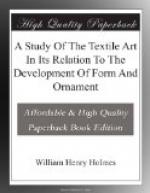[Illustration: Fig. 313. Basket with pendants of beads and bits of shell, work of the northwest coast Indians.—1/4.]
Fig. 313 illustrates the use of other varieties of pendants. A feather decked basket made by the northwest coast Indians is embellished with pendent ornaments consisting of strings of beads tipped with bits of bright shell. The importance of this class of work in higher forms of textiles may be illustrated by an example from Peru. It is probable that American art has produced few examples of tasseled work more wonderful than that of which a fragment is shown in Fig. 314. It is a fringed mantle, three feet in length and nearly the same in depth, obtained from an ancient tomb. The body is made up of separately woven bands, upon which disk-like and semilunar figures representing human faces are stitched, covering the surface in horizontal rows. To the center of these rosette-like parts clusters of tassels of varying sizes are attached. The fringe, which is twenty inches deep, is composed entirely of long strings of tassels, the larger tassels supporting clusters of smaller ones. There are upwards of three thousand tassels, the round heads of which are in many cases woven in colors, ridges, and nodes to represent the human features. The general color of the garment, which is of fine, silky wool, is a rich crimson. The illustration can convey only a hint of the complexity and beauty of the original.
[Illustration: Fig. 314. Tassel ornamentation from an ancient Peruvian mantle.]
We have now seen how varied and how striking are the surface characters of fabrics as expressed by the third dimension, by variation from a flat, featureless surface, and how all, essential and ornamental, are governed by the laws of geometric combination. We shall now see how these are related to color phenomena.
COLOR PHENOMENA.
Ordinary features.—In describing the constructive characters of fabrics and the attendant surface phenomena, I called attention to the fact that a greater part of the design manifested is enforced and supplemented by color, which gives new meaning to every feature. Color elements are present in the art from its very inception, and many simple patterns appear as accidents of textile aggregation long before the weaver or the possessor recognizes them as pleasing to the eye. When, finally, they are so recognized and a desire for greater elaboration springs up, the textile construction lends itself readily to the new office and under the esthetic forces brings about wonderful results without interfering in the least with the technical perfection of the articles embellished. But color is not confined to the mere emphasizing of figures already expressed in relief. It is capable of advancing alone into new fields, producing patterns and designs complex in arrangement and varied in hue, and that, too, without altering the simple, monotonous succession of relievo characters.




